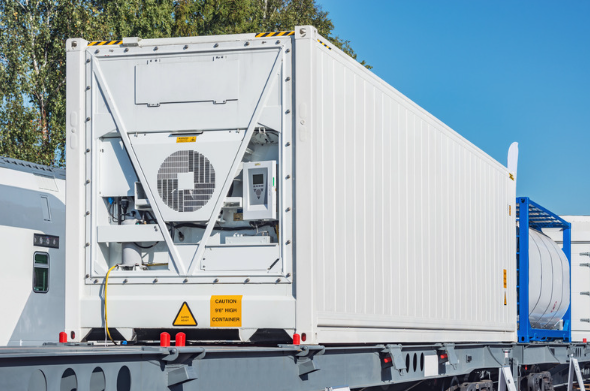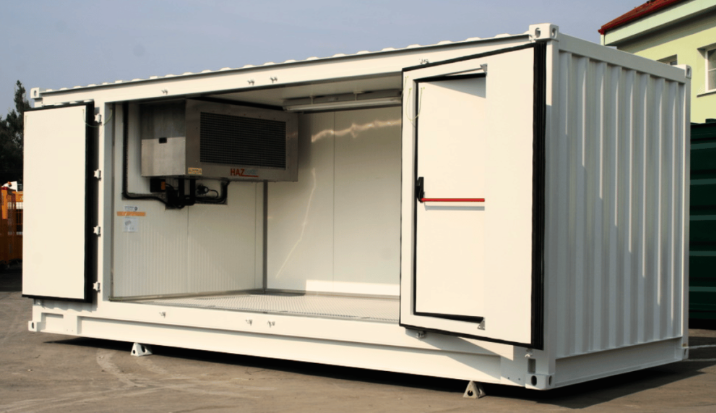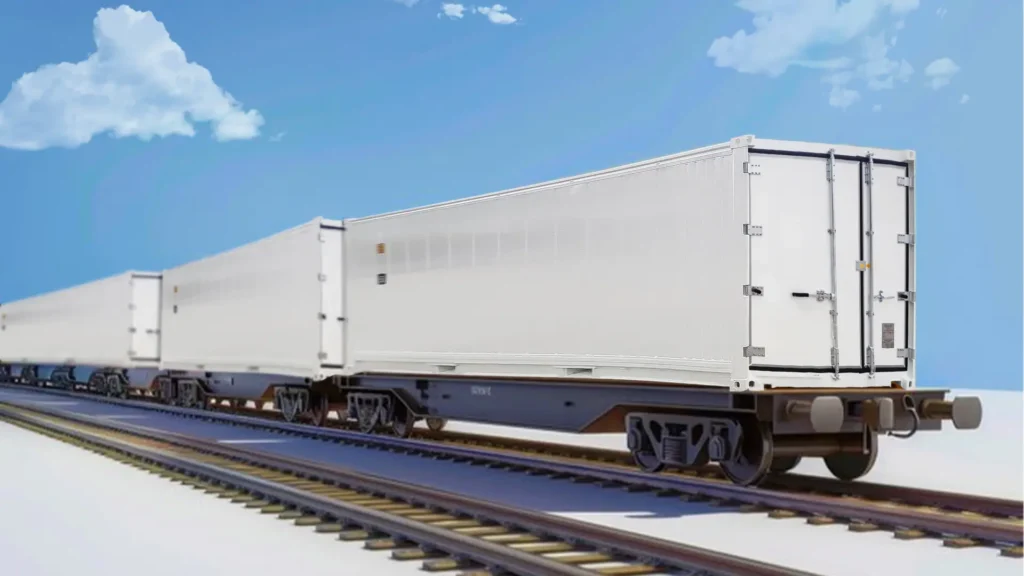In the ever-evolving world of global logistics, the importance of temperature-sensitive transportation has never been more critical. Whether you’re shipping fresh produce, frozen seafood, pharmaceuticals, or temperature-controlled electronics, using a reefer container in 2025 ensures your goods arrive in pristine condition. A reefer container, short for “refrigerated container,” is a specially designed intermodal shipping container equipped with a built-in refrigeration unit to maintain a specific temperature range from origin to destination.
As e-commerce expands and consumer demand for fresh products rises, cold chain logistics have become an integral part of shipping strategies worldwide. Reefer containers offer consistent, reliable climate control, making them the go-to solution for industries where product integrity hinges on strict temperature compliance. Whether you’re a logistics manager, food exporter, pharmaceutical distributor, or a newcomer exploring cold chain shipping, understanding how reefer containers work is essential for success in 2025.
What Is a Reefer Container?
A reefer container is a temperature-controlled container that can cool, freeze, or even heat goods during transportation. Unlike passive containers that rely on external chilling, reefers have an active refrigeration unit powered by an external power source—whether that’s a ship’s power system, a truck’s generator, or a plug-in facility at a port or depot. These containers come in standard ISO sizes (20-foot and 40-foot are most common), making them compatible with intermodal shipping systems, including rail, sea, and road transport.
Thanks to precise climate control, a reefer container can maintain internal temperatures ranging from -30°C to +30°C, depending on the cargo’s needs. Some high-tech models in 2025 even offer humidity control, real-time temperature monitoring, and alerts, making compliance easier than ever for shippers managing perishable goods.
Why Use Reefer Containers in 2025?
The demand for reefer containers has surged in 2025 due to several key trends:
- The global rise in fresh food exports and imports.
- Growth in direct-to-consumer perishable delivery.
- Increased pharmaceutical shipping post-COVID and amidst climate-related health concerns.
- Expanded global trade routes requiring longer transit times with temperature-sensitive cargo.
In short, if your products are vulnerable to heat, cold, moisture, or spoilage, reefer containers are no longer optional—they’re mission-critical.
Industries That Depend on Reefer Containers
Reefer shipping is indispensable across a wide range of industries in 2025:
- Food & Beverage: Meat, dairy, seafood, fruits, vegetables, and even wine require specific climate conditions to maintain freshness and prevent contamination. A reefer container ensures consistent cold chain logistics from farm to fork.
- Pharmaceuticals & Life Sciences: Vaccines, medications, and biologics often have stringent temperature requirements. A reefer container ensures regulatory compliance while preserving the efficacy of delicate medical products.
- Floriculture & Horticulture: Flowers, plants, and seedlings are highly sensitive to temperature changes. Reefers provide a stable microclimate, ensuring quality upon delivery.
- Electronics & Chemicals: Some electronics and chemical products are also sensitive to extreme temperatures or require humidity control. Modern reefer containers can cater to both.
- Specialty Goods: From high-end chocolates to gourmet cheese, niche exporters in 2025 rely on reefer shipping containers to preserve their brand reputation and avoid spoilage-related losses.
How Do Reefer Containers Work?
A reefer container works by drawing power from its transport method (ship, truck, or rail) or a plug-in terminal to operate an integrated refrigeration system. Cold air is circulated continuously within the container, often from the bottom through a T-shaped decking system that ensures even distribution.
Advanced reefer containers in 2025 also include:
- Real-time monitoring systems for temperature, humidity, and container location.
- Smart sensors and IoT integration for early warnings in case of mechanical failures or temperature deviations.
- Remote access to adjust temperature settings mid-transit if needed.
This ensures that your cargo stays within the desired climate range, even during long hauls or customs delays.
Intermodal Shipping with Reefer Containers
A major advantage of reefer containers is their compatibility with intermodal transport, which allows seamless transitions between trucks, trains, and ships without unpacking the cargo. This minimizes handling, reduces the risk of contamination, and preserves the internal climate throughout the entire shipping route.
In 2025, many reefer units are designed with GPS and energy efficiency in mind, making intermodal transport not only viable but optimal for global cold chain shipping. Whether you’re moving fresh blueberries from British Columbia to Japan or pharmaceuticals from Ontario to the U.S., reefer containers allow for smooth, temperature-stable transit across multiple borders and regulations.
Reefer Container Shipping Tips for 2025
Shipping with reefer containers in 2025 involves more than just loading and cooling. Here are key tips to ensure hassle-free, safe, and efficient reefer shipments:
- Pre-cool the container: Don’t load warm cargo into a cold container. Pre-cool both the container and the cargo to prevent temperature shock and uneven distribution.
- Evenly distribute the load: Proper airflow is crucial in a reefer container. Leave enough space between cargo and walls, and never block the air ducts or floor channels.
- Use proper packaging: Not all packaging is reefer-ready. Use ventilated and moisture-resistant materials to protect against humidity, condensation, and shifting temperatures.
- Work with reefer-savvy partners: Choose freight forwarders, carriers, and customs brokers who understand reefer shipping requirements. Compliance failures can result in spoiled cargo, costly insurance claims, and reputational damage.
- Monitor in real-time: Leverage technology. Smart reefers with IoT sensors allow you to track temperature, humidity, and shock in real-time—critical for high-value or fragile shipments.

What Is A Reefer Container?
A refrigerated container, or “reefer” is a specialized containment unit designed to transport temperature-sensitive goods at precise temperatures. It functions as a large refrigerator, capable of maintaining temperatures between -30°C and +30°C.
Reefer containers are equipped with a refrigeration unit at one end. When connected to a power source, this unit circulates chilled air throughout the container. This constant airflow ensures that the desired temperature is consistently maintained within the unit.
How Does Reefer Container Work?
Refrigerated containers, or reefers, are designed to maintain a controlled environment throughout transit, ensuring the preservation of temperature-sensitive cargo. Key factors to consider when shipping reefer cargo include –
- Temperature
Reefers can typically maintain temperatures between -25°C and +25°C, suitable for both chilled and frozen goods. Some units can even reach -35°C or lower, while specialized “super freezers” can maintain temperatures as low as -70°C.
- Ventilation
Air circulation is essential for removing heat and gases from a cooled cargo. Transport boxes should have ventilation features, and fresh air ventilation is often required for fruits and vegetables. For frozen goods, air should flow around the cargo, with minimal gaps between the cargo and the container walls.
- Humidity
While a lower humidity level may benefit certain products, reefer units typically maintain a relative humidity (RH) between 60% and 85%. Dehumidification functions can be used to reduce moisture levels. And newer units may achieve even lower levels.
- Drainage
Drainage systems are designed to prevent water gathering and insect intrusion within the container.
- Power Supply
Reefer machinery requires an electrical power source, which can be provided by a depot, terminal, vessel, or generator set connected to the units.
- Monitoring and Recording
A microprocessor within the container records temperature data. Including supply and return air temperatures, cargo probe readings, defrost activity, setpoint changes, and power on/off times.
Cargo probes can be used to monitor specific product temperatures, while additional monitoring devices can provide more real-time insights into temperature data.
- Pre-Cooling
It’s important to note that refrigeration units are designed to maintain a specific temperature and not to bring the cargo to any desired temperature.
Therefore the cargo should be pre-cooled to the set point temperature before loading, especially for fresh products. As, this helps to ensure optimal quality and shelf life.

Some Common items Shipped with Reefers
What Is A Reefer Container Used For?
Reefer containers are giant refrigerators that keep food and other things cold. They’re used to ship stuff worldwide, from fruits and vegetables to medicine and flowers. They’re also helpful at parties and festivals for storing food and drinks.
These containers have a built-in machine that keeps things cool, both while moving and sitting still. Making sure all your deliveries remain constantly fresh and usable.
Conclusion
As global supply chains become more interconnected and the demand for perishable goods increases, the role of the reefer container has evolved from optional to essential. In 2025, businesses that rely on temperature-sensitive cargo—whether fresh food, pharmaceuticals, floral products, or high-value chemicals—must integrate reefer shipping solutions to remain competitive. This isn’t just about preserving cargo; it’s about safeguarding your brand reputation, ensuring regulatory compliance, and meeting consumer expectations for quality and reliability.
Reefer Containers: Innovation Meets Efficiency
Today’s reefer containers are built to be smarter, safer, and more efficient than ever before. With advanced refrigeration technologies, IoT-enabled temperature monitoring, GPS tracking, and automatic alerts, shipping sensitive goods across continents has never been more manageable. These innovations allow shippers to remotely monitor and adjust container settings in real-time, reducing the risk of spoilage, delay-related damage, or regulatory fines.
Furthermore, the energy efficiency of modern reefer units supports the sustainability goals of logistics companies and global retailers alike. With environmental regulations tightening in many parts of the world, using a reefer container in 2025 doesn’t just make sense logistically—it makes sense environmentally and ethically.
Global Trends Shaping Reefer Shipping
The explosion in e-commerce for perishables—especially direct-to-consumer grocery and meal kit services—means more businesses are entering the reefer container space. Urban centers across Canada, the U.S., Europe, and Asia are seeing a rise in cold chain micro-fulfillment centers. Additionally, pharmaceutical distribution continues to demand strict temperature control for vaccines, specialty medications, and clinical trials—driving consistent reefer usage on air, sea, and ground freight.
Other trends include:
- Decentralized warehousing, allowing reefers to support smaller, agile hubs.
- Omnichannel distribution, where reefer containers connect B2B and B2C channels.
- Transloading partnerships, where goods are shifted efficiently from long-haul reefers to smaller delivery units without breaking the cold chain.
Reefer Containers and Intermodal Synergy
One of the biggest advantages of using reefer containers in 2025 is their seamless compatibility with intermodal transport. Businesses can move goods efficiently across long distances using ships or rail and then transition to truck for final-mile delivery—all without unloading or compromising temperature control.
This intermodal synergy means:
- Lower freight costs (especially for long-haul routes).
- Faster delivery windows.
- Fewer handling risks.
- Reduced emissions and carbon footprint.
Whether shipping produce from Ontario to California or pharmaceuticals from Montreal to Mexico, reefer containers and intermodal logistics deliver the ideal combination of precision and flexibility.
Making the Right Reefer Choice
When choosing a reefer container, consider your cargo’s temperature sensitivity, required humidity levels, shipment duration, and compliance needs. Partner with freight forwarders or logistics companies who specialize in reefer transport and can offer value-added services such as pre-cooling, document handling, and customs clearance. Also, ensure your operations staff understands how to pack, load, and monitor reefer containers correctly to avoid costly mistakes.
At the same time, use digital shipping platforms or 3PLs that offer real-time tracking and climate control data. In 2025, the most successful businesses aren’t just using reefer containers – they’re leveraging the full ecosystem of smart cold chain logistics to deliver superior customer experiences.
Final Thoughts
In an increasingly temperature-sensitive world, the reefer container is no longer a niche solution – it’s a cornerstone of smart, scalable, and resilient logistics. Whether you’re an experienced shipper or a newcomer to the cold chain, investing in the right reefer strategies now will ensure you stay competitive and compliant in 2025 and beyond.
With technology, global connectivity, and customer demand all pointing toward rapid growth in reefer shipping, now is the time to build or strengthen your cold chain capabilities. Take the time to evaluate your shipping lanes, product requirements, and logistics partners, and make sure your goods are protected with the right container, route, and process.
If you’re ready to future-proof your logistics, a reefer container could be your smartest move yet.
Contact RailGateway today for a free quote or more information!

FAQ’s
1. What exactly is a reefer container?
A reefer container, short for “refrigerated container,” is a specialized shipping container designed to maintain a set internal temperature for perishable or sensitive cargo. It has an integrated refrigeration unit that operates on electric power, making it ideal for transporting food, medicine, and temperature-sensitive goods. Reefer containers come in standard sizes and are compatible with all major modes of intermodal shipping.
2. What temperature range can a reefer container maintain?
Modern reefer containers can maintain temperatures from as low as -30°C to as high as +30°C, depending on the product and shipment requirements. Some units also offer humidity and ventilation controls, making them suitable for a wide variety of goods. This level of climate precision is critical for ensuring safety and compliance, especially in 2025’s global shipping environment.
3. Are reefer containers used for international shipping?
Yes, reefer containers are widely used in international shipping, particularly for items that must remain fresh, frozen, or stable over long distances. They can be used in sea freight, air cargo, rail transport, and truck delivery, making them highly adaptable for global trade. Thanks to standard ISO sizing, they integrate seamlessly into intermodal logistics systems.
4. How do I know if I need a reefer container?
If your cargo is perishable, temperature-sensitive, or regulated by temperature standards—such as food, medicine, cosmetics, or chemicals—you likely need a reefer container. It’s also important to consider transit time, geographic climate, and destination infrastructure. Consulting with a cold chain logistics provider will help determine the best solution for your product.
5. What’s the difference between a reefer container and a standard container?
A standard container is simply a metal box for dry goods, offering no climate control or insulation. A reefer container, by contrast, includes a refrigeration unit and is designed to actively maintain a specific temperature range. This makes reefers essential for cold chain logistics and ensures goods remain safe and compliant throughout transit.
6. How do reefer containers maintain temperature during transit?
Reefer containers use advanced refrigeration units powered by electricity or diesel generators to regulate internal temperatures. They continuously monitor and adjust conditions to keep cargo fresh, making them essential for perishable goods shipping.
7. What types of products are best shipped using reefer containers?
Reefer containers are perfect for shipping perishable items such as fruits, vegetables, dairy, seafood, pharmaceuticals, and frozen foods. Their temperature control ensures product quality and safety throughout the journey.
8. Can reefer containers be used in intermodal shipping?
Yes, reefer containers are fully compatible with intermodal shipping, seamlessly transferring between ships, trucks, and trains. This flexibility helps maintain cold chain integrity from origin to destination.
9. What are the common temperature settings in reefer containers?
Reefer containers typically operate within a range from -30°C to +30°C (-22°F to 86°F), depending on the cargo requirements. Precise temperature control helps preserve freshness and prevents spoilage.
10. How can businesses ensure reefer container shipments are hassle-free?
To avoid issues, it’s important to properly pack goods, set correct temperature settings, and monitor the container’s performance during transit. Partnering with experienced logistics providers specializing in reefer container shipping also guarantees smooth handling.
Additional Resources
How We Can Help
For businesses looking to optimize their freight shipping with reliable, efficient, and cost-effective solutions, RailGateway.ca is your trusted partner in intermodal logistics. Whether you’re new to freight trains or want to enhance your existing supply chain, our team of intermodal experts is ready to guide you every step of the way.
Contact RailGateway.ca today for a free quote or to speak directly with one of our experienced intermodal specialists. Let us help you unlock smarter, smoother shipping solutions tailored to your unique needs.
Visit RailGateway.ca or call us to get started on transforming your freight shipping strategy in 2025 and beyond.





